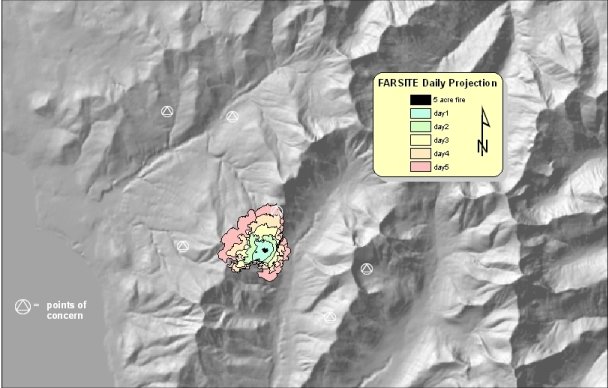Why Use FSPro Instead of FARSITE?
Fire Area Simulator (FARSITE) (Finney 1998) is a fire simulation model used over a short period of time (1-5 days) where there is a good confidence in the predicted weather. If we want to get an idea as to where and when a fire might spread in a few days using forecasted weather, FARSITE is the appropriate application to use. When a reliable weather forecast is used, FARSITE is useful for answering questions such as the following:
- What is the predicted fire size and shape over the next 1 to 5 days?
- What are the likely fire behavior characteristics within the predicted fire perimeter?
- When will the fire reach specific points of concern?
If you are online, you can view the animated example of a five-day FARSITE simulation using a five-day weather forecast. The small black polygon is the original perimeter, as well as the ignition used in FARSITE. The different colors represent each day's fire growth. The following image shows the fire reaching a point of concern on Day 5 of the simulation. The animation will repeat five times and end.
This figure shows the results of the 5-day simulation with the legend.

Five-day FARSITE with Legend
While FARSITE can be used to simulate fire growth for periods of 5 days or more, it uses only one forecasted wind-weather scenario and offers no information as to the probability of an area being impacted under multiple wind and weather scenarios. This limitation combined with a single run eliminates the use of this model to answer questions related to probability analysis.
Simulation durations lasting much more than 5 days lie outside the reliability of forecasted weather information. FSPro overcomes this by generating hundreds of potential wind and weather scenarios (based on the current season's weather as well as historic weather) and incorporates this information in simulating thousands of individual fires. By accounting for uncertainty in the weather and running multiple simulations, long-term analyses using FSPro provides risk-based assessments for strategic decision making.
It is important to understand that weather forecasts become less reliable the further out the forecast. That is why FARSITE is not recommended for analyses beyond about five days (the time period of a reliable forecast). Using a weather forecast for 14 days from today may not be much better than using historic climatology.
In This Section |
See Also |
Reference |